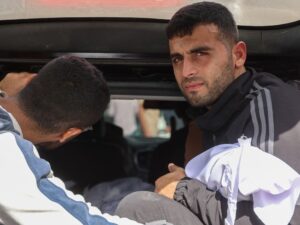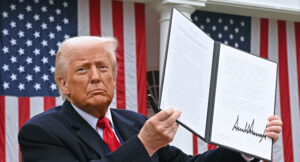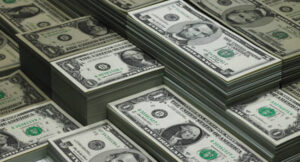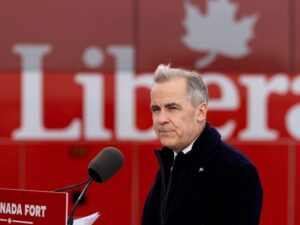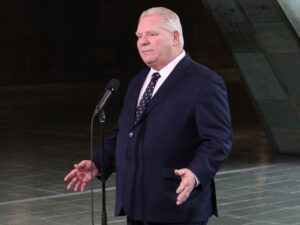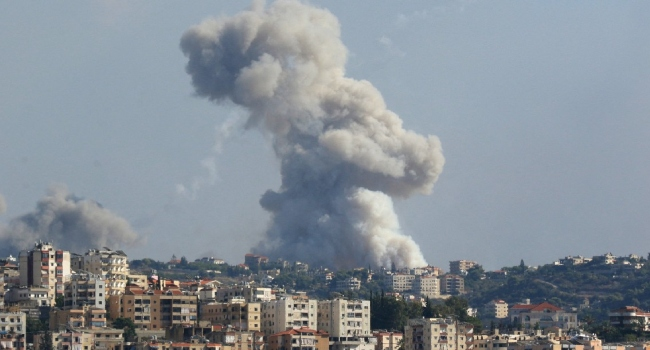
Israeli air strikes killed 274 people, including 21 children, in Lebanon on Monday, the Lebanese health minister said, in by far the deadliest cross-border escalation since war erupted in Gaza on October 7.
War began when Palestinian militant group Hamas carried out the worst-ever attack on Israel, with Hezbollah and other Iran-backed groups around the region drawn into the violence.
Israel said it hit about 800 Hezbollah sites in south and east Lebanon during the day and carried out a “targeted strike” later in Beirut. A source close to Hezbollah said the strike on the capital targeted a senior operative from the group.
Lebanese state media reported a new wave of raids in the country’s east, while Hezbollah said it targeted five sites in Israel.
The Israeli strikes killed 274 people in Lebanon, including 21 children and 39 women, Health Minister Firass Abiad said, adding about 5,000 people had been wounded since Tuesday.
World powers have implored Israel and Hezbollah to pull back from the brink of all-out war, with the focus of violence shifting sharply in recent days from Israel’s southern front with Gaza to its northern border with Lebanon.
“We sleep and wake up to bombardment… that’s what our life has become,” said Wafaa Ismail, 60, a housewife from the southern Lebanese village of Zawtar.
The Israeli military said it hit “approximately 800 Hezbollah terror targets in southern Lebanon and in the area of Bekaa deep inside Lebanese territory”.
Israeli military spokesman Rear Admiral Daniel Hagari warned of further strikes and told people in Lebanon to avoid potential targets linked to Hezbollah.
Abiad said “thousands of families from the targeted areas have been displaced”.
Bilal Kachmar, an official in Tyre, said hundreds had fled their homes, while AFP correspondents saw rows of cars leaving the nearby city of Sidon.
The Israeli military also warned people living in the Bekaa valley, in eastern Lebanon, to flee their homes, as it announced it was “broadening” the scope of its strikes.
Explosions around the ancient city of Baalbek in eastern Lebanon triggered flashes of fire and sent smoke billowing into the sky.
Advertisement
Lebanon’s official National News Agency (NNA) later reported new “enemy raids targeted the mountain” areas in the Baalbek region and several towns and villages, adding that “the Israeli enemy” launched a strike on the town of Hermel.
Hezbollah said it had fired rockets at military sites near Haifa.
It later said it launched “dozens of rockets” at two Israeli bases “in response to the Israeli enemy’s attacks on the south and the Bekaa”.
The education minister said schools in targeted areas would close for two days.
The NNA said Lebanese had received phone messages from Israel telling them to “quickly evacuate”.
Hezbollah, a powerful political and military force in Lebanon, has exchanged near-daily fire with Israel in support for its Palestinian ally Hamas.
Prime Minister Benjamin Netanyahu said on Monday that Israel was preempting threats and was acting to change the “security balance” in the north.
Hezbollah’s deputy chief, Naim Qassem, said Sunday the group was in a “new phase, namely an open reckoning” with Israel, and ready for “all military possibilities”.
They spoke after Hezbollah rocket attacks on northern Israel caused damage in the area of Haifa, a major city on Israel’s north coast.
On Sunday morning, hundreds of thousands of people in northern Israel fled to their bomb shelters as Hezbollah fired a barrage of rockets across the border.
The attack came after an Israeli air strike in Hezbollah’s southern Beirut stronghold on Friday killed its elite Radwan Force commander, Ibrahim Aqil, along with other commanders and civilians.
Last week on Tuesday and Wednesday, coordinated communications device blasts that Hezbollah blamed on Israel killed 39 people and wounded almost 3,000.
“No country can live like this,” said Ofer Levy, 56, a customs officer, who lives on the edge of Haifa.
Since the cross-border exchanges between Israel and Hezbollah began in October, tens of thousands of people on both sides have fled their homes.
An Israeli military official, who cannot be further identified under military rules, on Monday outlined the goals of the military operation.
It seeks to “degrade threats” from Hezbollah, push them back from the border, and then to destroy infrastructure built near the frontier by Hezbollah’s Radwan Force, the official said.
Lebanese Prime Minister Najib Mikati urged the United Nation and world powers to deter what he called Israel’s “plan that aims to destroy Lebanese villages and towns”.
US President Joe Biden, whose country is Israel’s main ally and weapons supplier, said his administration was “going to do everything we can to keep a wider war from breaking out”.
Ahead of the annual General Assembly in New York, UN chief Antonio Guterres warned of Lebanon becoming “another Gaza” and said it was “clear that both sides are not interested in a ceasefire” there.
Speaking at the General Assembly, Masoud Pezeshkian, the recently elected president of Iran — which backs Hezbollah and Hamas — accused Israel of seeking “to create this wider conflict”.
The UNIFIL peacekeeping force in south Lebanon meanwhile warned that “any further escalation of this dangerous situation could have far-reaching and devastating consequences”.
Hamas’s October 7 attack on Israel resulted in the deaths of 1,205 people, mostly civilians, according to an AFP tally based on Israeli official figures that include hostages killed in captivity.
Of the 251 hostages also seized by militants, 97 are still held in Gaza, including 33 the Israeli military says are dead.
Israel’s retaliatory military offensive has killed at least 41,431 people in Gaza, most of them civilians, according to figures provided by the Hamas-run territory’s health ministry. The UN has described the figures as reliable.


